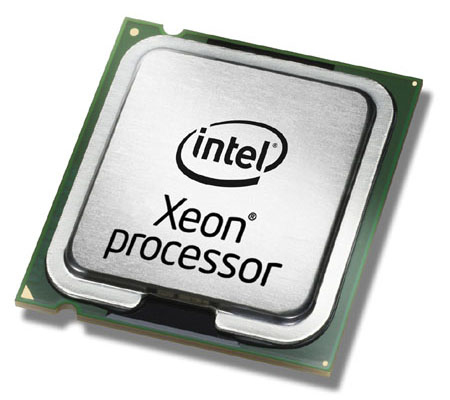Offer details
Related Products
Description
The Intel® Xeon® processor 5500 series automatically and intelligently adjusts server performance according to your application needs for an up to 9x performance gain over single-core servers1 at 18 percent less operating power. This enables you to achieve a 9:1 server consolidation ratio, reducing operating costs by up to 90 percent resulting in an estimated 8-month return on a new server investment. Click here to estimate the business benefits of refreshing your server environment.
Intelligent next-generation Intel® microarchitecture adapts to the workload, automatically increasing processor frequency for greater performance.
Better performance enabled by Intel® Turbo Boost Technology, increasing processor frequency and enabling faster speeds when conditions allow.
Lower energy costs while minimizing impact to performance by automatically putting processor and memory into the lowest available power state.
Individual cores are reduced to near-zero power independent of other operating cores.
Virtualize different generations of Intel® Xeon® processor–based servers in the same pool to deliver peak performance during high-use periods and automatically reduce energy cost during low-use periods.
Integrates multiple generations of Intel® Xeon® processor-based servers, improving flexibility for failover, load balancing, and disaster recovery.
Flexibility for 64-bit and 32-bit applications and operating systems.
- Up to 64 GB/s for three times the memory bandwidth over previous memory technology;
- Up to 144GB supports higher performance for data-intensive applications;
- Enhanced reliability, availability, and serviceability features.
- Moves data more efficiently for fast, scalable, and reliable network performance;
- Ability to significantly reduce CPU overhead, freeing resources for more critical tasks.
- Many memory controller features, together with PCI Express RAS features, combine to help improve platform reliability vs. previous-generation platforms;
- New features include Error Correcting Code (ECC) system bus, new memory mirroring and I/O hot-plug.
Intelligent next-generation Intel® microarchitecture adapts to the workload, automatically increasing processor frequency for greater performance.
Better performance enabled by Intel® Turbo Boost Technology, increasing processor frequency and enabling faster speeds when conditions allow.
Lower energy costs while minimizing impact to performance by automatically putting processor and memory into the lowest available power state.
Individual cores are reduced to near-zero power independent of other operating cores.
Virtualize different generations of Intel® Xeon® processor–based servers in the same pool to deliver peak performance during high-use periods and automatically reduce energy cost during low-use periods.
Integrates multiple generations of Intel® Xeon® processor-based servers, improving flexibility for failover, load balancing, and disaster recovery.
Flexibility for 64-bit and 32-bit applications and operating systems.
- Up to 64 GB/s for three times the memory bandwidth over previous memory technology;
- Up to 144GB supports higher performance for data-intensive applications;
- Enhanced reliability, availability, and serviceability features.
- Moves data more efficiently for fast, scalable, and reliable network performance;
- Ability to significantly reduce CPU overhead, freeing resources for more critical tasks.
- Many memory controller features, together with PCI Express RAS features, combine to help improve platform reliability vs. previous-generation platforms;
- New features include Error Correcting Code (ECC) system bus, new memory mirroring and I/O hot-plug.
Specifications
| Processor | |
|---|---|
| Processor base frequency | 2.26 GHz |
| Memory bandwidth supported by processor (max) | 25.6 GB/s |
| Thermal Design Power (TDP) | 80 W |
| Processor cache | 8 MB |
| Processor cache type | L3 |
| Processor model | E5520 |
| Processor threads | 8 |
| System bus rate | 5.86 GT/s |
| Processor operating modes | 64-bit |
| VID Voltage Range | 0.75 - 1.35 V |
| Processor boost frequency | 2.53 GHz |
| Number of QPI links | 2 |
| Bus type | QPI |
| Component for | Server/workstation |
| Processor lithography | 45 nm |
| Processor family | Intel® Xeon® 5000 Sequence |
| Processor cores | 4 |
| Processor socket | Socket B (LGA 1366) |
| Memory | |
| Maximum internal memory supported by processor | 144 GB |
| Memory types supported by processor | DDR3-SDRAM |
| Memory clock speeds supported by processor | 800,1066 MHz |
| Memory bandwidth supported by processor (max) | 25.6 GB/s |
| Memory channels | Triple-channel |
| ECC | Yes |
| Graphics | |
| On-board graphics card | No |
| Power | |
| Thermal Design Power (TDP) | 80 W |
| VID Voltage Range | 0.75 - 1.35 V |
| Features | |
| Thermal Design Power (TDP) | 80 W |
| Idle States | Yes |
| Execute Disable Bit | Yes |
| Number of Processing Die Transistors | 731 M |
| Processing Die size | 263 mm² |
| CPU configuration (max) | 1 |
| Market segment | Server |
| Processor special features | |
| Intel Virtualization Technology for Directed I/O (VT-d) | Yes |
| Intel Virtualization Technology (VT-x) | Yes |
| Intel® Turbo Boost Technology | Yes |
| Intel® Hyper Threading Technology (Intel® HT Technology) | Yes |
| Enhanced Intel SpeedStep Technology | Yes |
| Intel VT-x with Extended Page Tables (EPT) | Yes |
| Intel Demand Based Switching | Yes |
| Operational conditions | |
| Tcase | 72 °C |
| Technical details | |
| Market segment | Server |
| Other features | |
| Intel® Virtualization Technology (Intel® VT) | VT-d, VT-x |







